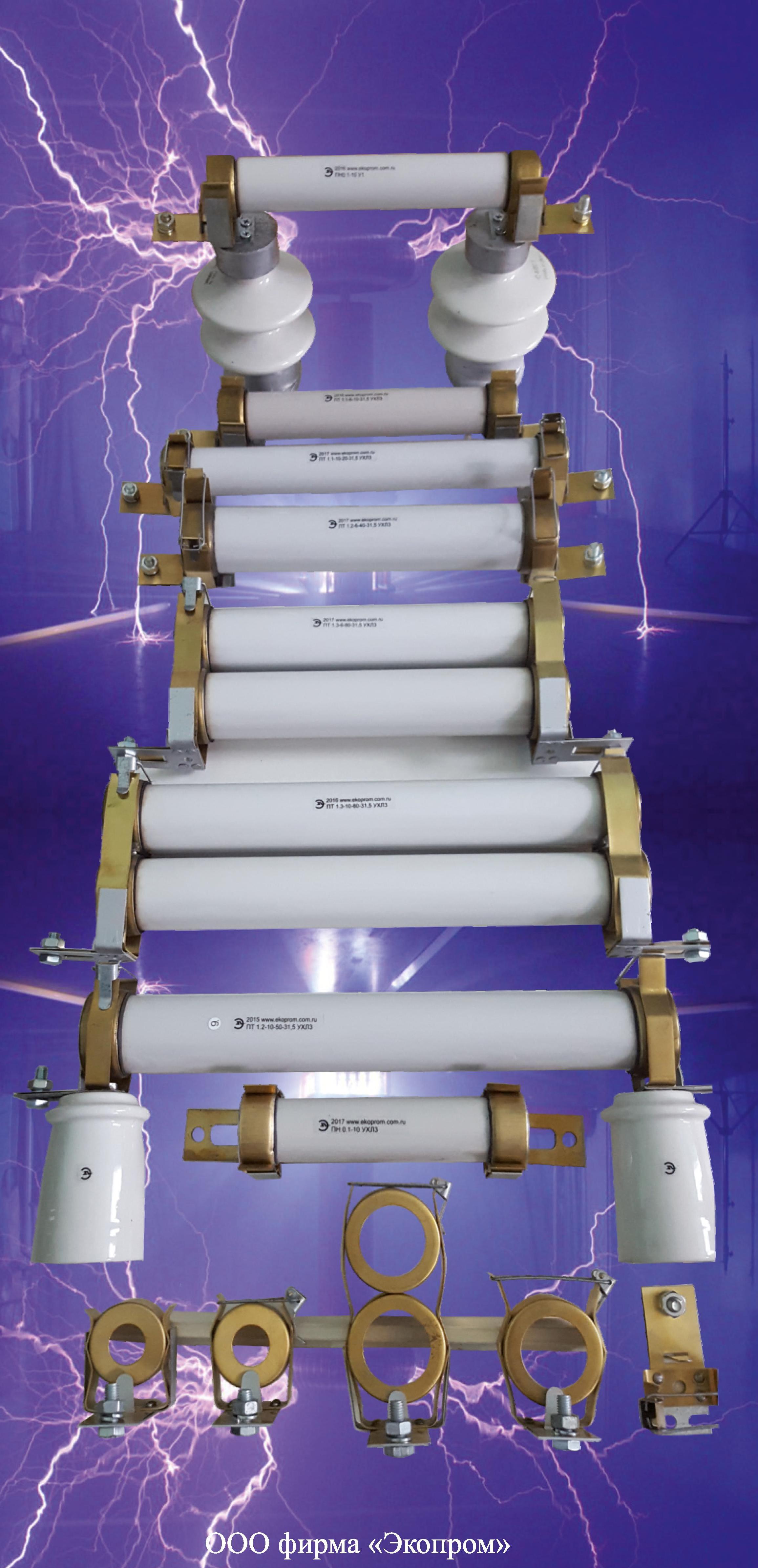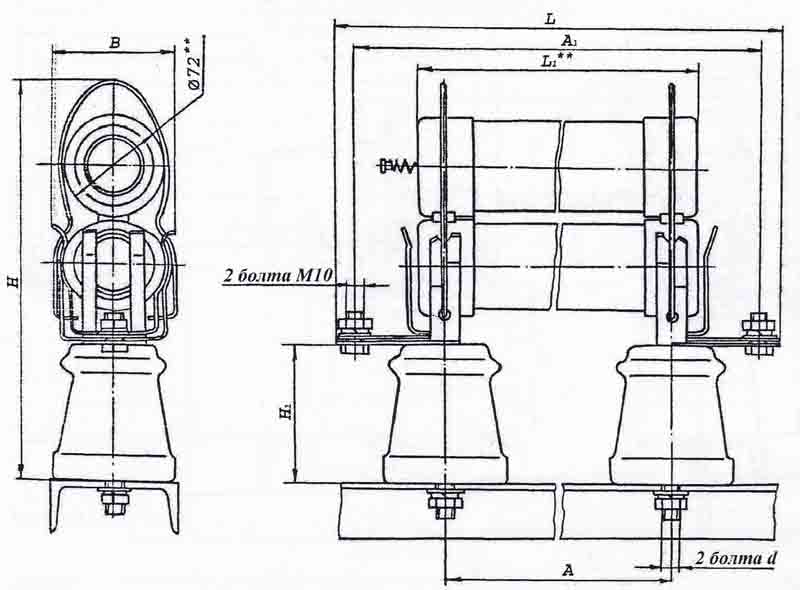High-voltage fuses and current-limiting fuse holders PKT, PKN are manufactured in accordance with GOST 2213-79
Fuses are available in the entire range of current values. A shipment is made the next day after payment.
Manufactured in accordance with GOST 2213-79

Electrical characteristics and dimensional specifications of fuse holders.
Fuses are the most common means of protecting electrical connections (cables and overhead lines) and machines against overload and short circuit current. The main places of installation and use of fuses are electric service panels and electrical schemes with different voltage levels, protection of various power transformers and measuring transformers (for example, voltage transformers NTMI, NKF) on the high-voltage side. Fuses are widely used in networks with voltage from 0.4 kV to 35 kV, in single-phase alternating current networks and three-phase alternating current networks at the AC frequency of 50 Hz and 60 Hz, direct current with different voltage levels.
For any type of fuse, the main element is a fuse holder, which is switched into circuit of the device that has to be protected. The fuse construction also includes a body made of insulating material and a contact part for installing and fixing the fuse in the circuit. Fuses are installed in special contacts on insulators.
Quartz-sand filler (with the content of silicon oxide not less than 98 %, humidity is not higher than 3 %) is used for all types of fuses that we offer. Preliminarily, sand is dried at 120-180°C. Sand grains have excellent thermal conductivity characteristics and a large cooling surface area. Electric arc burns in a narrow channel between the sand grains. At high currents of short circuit, the volt-ampere characteristic is growing, the current is sharply decreasing and hence the electrical device is protected from insulation breakdown and damage.
There are several types of fuses according to voltage classes. Fuses PN-2 and PN-0.1 are used at electrical installations with voltage under 1000 V. High-voltage fuses PKT (P – fuse, K – with quartz-sand filler, T – protection of transformers) are used at electrical installation with voltage above 1000 V. Fuse holders PKT with a porcelain body and brass caps are a part of high-voltage fuses PKT. They are designed to protect transformers (3-10 kV) on the high-voltage side. The filler is quartz sand, the fuse element is made ??of copper or nichrome (fuses PKN).
The use of high-voltage fuses PKT is possible in regions with a temperate climate (climatic category “U”, location category 1, reflected as U1) and moderately cold climate reflected as UHL (UHLZ), which meets regulatory requirements.
Actuation of fuses PKT and their fuse holders PT is based on melting of calibrated wire when strength of current flowing through it exceeds the nominal value. Melting time of the wire (fuse element) decreases with increasing the current value.
In such a case, electric arc in the high-voltage fuses is extinguished in the space between the grains of quartz sand. In case of a short circuit, the current value is large and the wire melts during the time less than a half-period of frequency; that is why short-circuit current does not reach its maximum value. Thereby fuse holders PKT perform a current limiting function under the conditions of fault clearance.
PKT complete set
PKT complete set includes a set of contact elements, two insulator units, and a current-limiting fuse holder PT. All fuse holders PT are certified and fully comply with the specifications and state standards.
|
Fuse holder type |
Nominal voltage, kV |
Nominal current, A |
Interrupting current, kA |
Fuse holder length, mm |
Cap diameter, mm |
|---|---|---|---|---|---|
|
PT 1.1 |
10 |
2;3,2;5;8;10; 16;20;31,5 |
12,5;31.5 |
412 |
55 |
|
PT 1.1 |
6 |
2;3,2;5;8;10; 16;20;31,5 |
20;40 |
312 |
55 |
|
PT 1.2 |
10 |
31,5;40;50 |
12,5;31.5 |
464 |
72 |
|
PT 1.2 |
6 |
31,5;40;50;80 |
31,5;20 |
364 |
72 |
|
PT 1.3 |
10 |
80;100 |
12,5;20;31.5 |
464 |
72 |
|
PT 1.3 |
6 |
80;100;160; |
20;31.5 |
364 |
72 |
|
PT 1.4 |
10 |
100;160;200 |
12,5;20;31.5 |
464 |
72 |
|
PT 1.4 |
6 |
160;200;315 |
20;31.5 |
364 |
72 |
|
PT-0.1 |
6;10 |
- |
- |
212 |
55 |
Preparation and installation of high-voltage fuses PKT.
All high-voltage fuses (including PKT) undergo inspection and revision before installation. An external inspection is carried out to check whether there are no defects at the contact points, insulators, connecting terminals and fuse holders. Fuse elements themselves are checked for integrity and electrical resistance with the use of a tester or other device (ohmmeter), as well as for reliability of the contact between fuse elements and caps, and between PT fuse holders’ caps and energizing jaws. In addition, markings that indicate ampere rating of the fuses are checked before the installation of the fuses PKT.
When installing the PT, it is important to make sure that their flag indicators are directed upwardly and visible to operating personnel. Isolators IO-6, 10 kV for the PKT are installed on the mounting surface in compliance with coincidence of axes of each jaw (allowed deviation ± 0.5 mm) with respect to the direct axis of the fuse holder. The insulator mount is fixed with the use of the bolts; each nut has to be tightened uniformly. According to the rules, before applying voltage, it is necessary to test insulation by means of applying test voltage for 1 min. These tests are carried out under higher voltage at the normal power frequency. The results are represented in the form of a test protocol.
Jaws PKT have to be clamped in a way that should provide a soft entry of the fuse holder PKT into jaws by hand without knocking and curving. At the same time, it is necessary to ensure a reliable contact in this connection point. At the top and at the bottom, arresting devices fix the fuse holder PKT and keep it from lengthwise vertical displacement. Connecting terminals’ locks of the high-voltage fuses PKT are also provided for in order to prevent falling out of the fuse holders under the conditions of dynamic vibration and mechanical shock. Immediately before the first installation of the fuse holder PT, to ensure above-mentioned requirements, dimensions between its outer planes - 55 ± 1 mm for PKN 001 and 101 PKT (for PKT 102 - 70 ± 2 mm) are checked and adjusted with a rigid clamp of jaws. A separate grounding terminal for bases of insulator units to earthing ring through a metal run is constructively possible.


Overall dimensions, installation dimensions and connecting dimensions of the fuses PKT 101,102,103 (UZ version)
1 — fuse holder; 2 — contact; 3 — insulator ; a — two bolts
|
Type |
Dimensions, mm |
Weight, kg |
|||||||
|---|---|---|---|---|---|---|---|---|---|
|
L |
L1 |
A |
A1 |
H |
H1 |
B |
d |
||
|
PKT 101-6 |
420 |
312 |
396±2 |
285±1 |
176 |
109±2 |
77 |
10 |
3,9 (1,4)* |
|
PKT 101-10 |
520 |
412 |
496±2 |
385±1 |
196 |
120±2 |
82 |
10 |
4,9 (1,8)* |
|
PKT 102-6 |
466 |
364 |
330±1 |
442±2 |
215 |
100±1 |
84 |
Ì10 |
5,0 (2,3)* |
|
PKT 102-10 |
566 |
464 |
430±1 |
542±2 |
235 |
120±1 |
84 |
Ì10 |
6,3 (2,91)* |
|
PKT 103-6 |
466 |
364 |
330±1 |
442±2 |
290 |
100±1 |
84 |
Ì10 |
7,3 (4,5)* |
|
PKT 103-10 |
566 |
464 |
430±1 |
542±2 |
310 |
120±1 |
84 |
Ì10 |
9,2 (5,8)* |
*The weight of replaceable fuse element is given in brackets
About the company Production Contact information
© 1999—2014 LLC “Ekoprom”
Electrotechnical industry of Russia
Design — «Stav-Seo»







